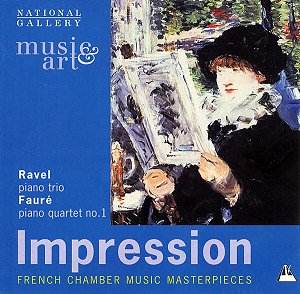|
|
Search MusicWeb Here |
|
 |
||
|
Founder:
Len Mullenger (1942-2025) Editor
in Chief:John Quinn
|
|
|
Search MusicWeb Here |
|
 |
||
|
Founder:
Len Mullenger (1942-2025) Editor
in Chief:John Quinn
|
 |
Impression. French Chamber Music Masterpieces
Gabriel FAURÉ (1845-1924): Piano Quartet No. 1 in C minor* Maurice RAVEL (1875-1937): Piano Trio Recorded at Potton Hall, Suffolk 20-21 June 2000 |
| CD available for post-free online mail-order or you may download individual tracks. For some labels you can download the entire CD with a single click and make HUGE savings. The price you see is the price you pay! The full booklet notes are available on-line. |  |
|
NOTE • Click on the button and you can buy the disc or read the booklet details • You can also access each track which you may then sample or down load. • Further Information. |
|
|
The title of this CD reflects the impetus behind the recording. It was made to coincide with the exhibition at the National Gallery in London entitled ‘Impression: Painting Quickly in France, 1860-1890’ which was held between November 2000 and January 2001. The exhibition brought together a significant number of impressionist masterpieces from collections all over the world.
It is a moot point whether the two composers represented here should be tagged as ‘Impressionists’, Fauré especially. That said, it was an appropriate gesture to further celebrate French culture by programming two masterpieces from that country’s chamber music repertoire. Though the two works are very different in style and character they are both fastidious compositions and there is a meaningful link in that Ravel was at one time among Fauré’s pupils.
The Fauré quartet is a relatively early work, composed in 1879 though the finale was substantially revised four years later. It is a strong and characterful piece with an assertive, forward-moving first movement, a mercurial scherzo, a grave and elegiac slow movement and an energetic, propulsive finale. The four distinguished British musicians who constitute Juno’s Band are keenly responsive to its different moods and give a convincing and atmospheric performance. I was particularly impressed with their sensitive rendition of the serenely beautiful slow movement which is an excellent example of Fauré’s subtly expressive art.
The players also respond well to the more allusive sound world of Ravel. His trio, which dates from 1914, has many translucent pastel passages but it is a strong piece also ("broad and powerful" the anonymous note writer calls it.) It seems to me that the players have the right range of tone at their disposal to do justice to the piece. As with the Fauré, I especially warmed to their eloquent account of the slow movement, in this case a passacaglia, which they build from a quiet, sombre beginning into an impressive musical edifice.
Chamber music involving piano and strings presents potentially huge problems of balance for it is all too easy for the piano to dominate. Fauré’s piano writing, in particular, can be heavy in the wrong hands for he conceived it for the lighter-sounding French pianos of the day, such as Pleyels, which were much less heavy than the concert grands of today. There are no serious problems of balance here for which credit must go to the sensitive Ian Brown and to the engineers. In fact the recorded sound is very satisfactory, placing the performers in a natural perspective and allowing a good amount of bloom round the sound without excessive reverberation.
These are good, sensitive and idiomatic performances of two great French chamber works. As far as I know this coupling is unique on CD. If the coupling appeals this CD is well worth adding to your collection. John Quinn |
FAURE RAVEL Get a free QuickTime download here |
|
ADDITIONAL INFORMATION •
You can sample only 30 seconds (or 15% if that is longer) of a given track. Select from the View tracks list. Each sample will normally start from the beginning but you can drag the slider to any position before pressing play. • PLEASE NOTE: If you are behind a firewall and the sound is prematurely terminated you may need to register Ludwig as a trusted source with your firewall software.
•You will need Quicktime to hear sound samples. Get a free Quicktime download here • If you cannot see the "Sample All Tracks" button you need to download Flash from here.
|
|
|
Return to Index |